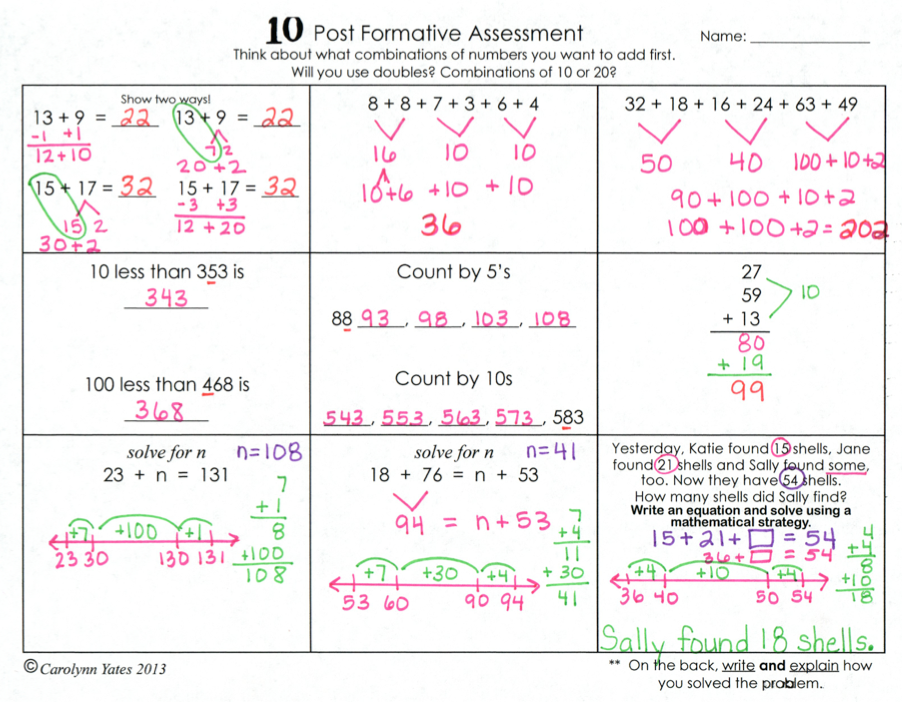The
files below are a quick way to capture a students understanding of the
various strategies used in Addition and Subtraction units. Each
question within an activity is designed to progressively become more
challenging, allowing you to quickly identify each student's
instructional level. Answer sheets are provided, but are only possible
approaches, there may be other ways to demonstrate understanding.
Addition Within 1000 and Applied Problems
Here are a few samples! There are 10 sheets and 10 answer sheets in the packet!
Click HERE for link to the Packet
Addition Within 1000 and Applied Problems
Student Friendly Standards
* OA1 I can solve word problems using objects, drawings, and equations.
* OA2 I can use mental strategies (using doubles plus one, bridging through 10) to easily add within 20.
* NBT5 I can easily add numbers within 1000 by using strategies I have learned
(decomposing, branching, partial sums, etc)
* NBT6 I can add up to 4 two-digit numbers by using strategies I have learned.
* NBT8 I can add and subtract 10 or 100 to another number in my head.
* NBT9 I can use place value to explain addition.
* OA1 I can solve word problems using objects, drawings, and equations.
* OA2 I can use mental strategies (using doubles plus one, bridging through 10) to easily add within 20.
* NBT5 I can easily add numbers within 1000 by using strategies I have learned
(decomposing, branching, partial sums, etc)
* NBT6 I can add up to 4 two-digit numbers by using strategies I have learned.
* NBT8 I can add and subtract 10 or 100 to another number in my head.
* NBT9 I can use place value to explain addition.
This packet can be used:
~ as a formative assessment to share with parents
~ as a common assessment to use for regrouping among grade level teams
~as a tool to set ability groups and differentaite instruction
~ as a tool to fill the gaps and find individual strengths and weaknesses
~ to group students by the skill or standard that they have not yet mastered
~ in small groups as a tool to instruct, offer guided practice, and monitor independent practice
Decomposing
~ as a formative assessment to share with parents
~ as a common assessment to use for regrouping among grade level teams
~as a tool to set ability groups and differentaite instruction
~ as a tool to fill the gaps and find individual strengths and weaknesses
~ to group students by the skill or standard that they have not yet mastered
~ in small groups as a tool to instruct, offer guided practice, and monitor independent practice
Here are just a few of the strategies that I have introduced to my students:
Decomposing
Composing
Branching
The Pull Down Method
Partial Sums
Open Number Line
Click HERE for link to the Packet
Click HERE for link to the Packet
I feel that it is important that my students demonstrate mastery of the various strategies. Later, as I provide performance tasks, I will be asking the students to choose a strategy from the ones above or a strategy that they have created themselves; as long as they can articulate their mathematical thinking clearly to others. Practicing and mastering the above strategies while eliciting other approaches will help children acquire a deeper understanding of our Base Ten System.
I have provided sample answer sheets. Please note that because the Common Core asks children to think critically, while being able to justify how they arrived at their answer in an efficient way. The answers provided are considered “POSSIBLE” answers. Children may have others ideas. However, they must be able to demonstrate how they arrived at their answer. “I memorized it” is not an explanation. The Common Core also encourages automaticity while exercising flexibility in adding and subtracting through the breaking apart and putting together of numbers. This is why showing doubles and bridging through 10s and 20s in Mental Math activities must be practiced and demonstrated.
I feel that it is important that my students demonstrate mastery of the various strategies. Later, as I provide performance tasks, I will be asking the students to choose a strategy from the ones above or a strategy that they have created themselves; as long as they can articulate their mathematical thinking clearly to others. Practicing and mastering the above strategies while eliciting other approaches will help children acquire a deeper understanding of our Base Ten System.









